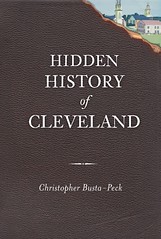According to The Encyclopedia of Cleveland History, the Austin Powder Company is the oldest manufacturing enterprise in Cleveland, founded in 1833 by the five Austin brothers. The explosives the company produced were used to blast rock for the canals being built at that time. Interestingly, when the brothers bought 1,200 acres and built a production facility in Glenwillow in 1892, they also built homes for its employees, a town hall, a school, and a general store, essentially forming the “company town” of Glenwillow. The Austin Powder company headquarters were originally located in the Rockefeller building in downtown Cleveland.
The Coleman family could only have lived in this house for approximately five years before they sold the home. They then moved up West 14th St. to 163 Jennings Avenue, which translates to #2307 where Grace Hospital now stands.
The home passed through the hands of a series of owners before William Dem (shortened from Demko) who lived next door in an Italianate where the gas station now sits, purchased the home in 1934. It stayed in the Dem family for 65 years until 1999, at which time William’s granddaughter sold it to a neighbor. The neighbor ran the home as a boarding house. After he passed away, the current owner Michele purchased the property.
Michele is very focused on the care and maintenance of the inside of the home, and it will be easy for you to see why.

Once you pass through the added on enclosed porch there are two interior doors. The first is a set of double doors.

The second is a very large Dutch door.

Through the Dutch door you will find a built-in sitting area to your left. Directly ahead is the main staircase.


The spandrel decorating the front staircase is undoubtedly the highlight of this home. The intricacy of the woodwork is unparalleled.

The owner has an old architecture advertisement featuring this type of fretwork. The ad is for C.S. Ransom & Company based in Cleveland that could have potentially produced this piece.

At the top of the stairwell you will find these prominent newel caps.

There are five fireplaces in the home.

The fireplace in the master bedroom has a cabinet that opens overhead for storage.

There is an asymmetrical fireplace on the second floor with decorative shelves on the left. This is extremely similar to the asymmetrical fireplace that Schweinfurth had in his own home.

Surprisingly there is a lot of storage including a butler's pantry and larger closets than what is typical for this time. There is also a room devoted specifically to built-in storage on the upstairs level.


There is a stationary window featured in the sunroom with decorative lattice woodwork in the upper pane.

The owner discovered in the dining room that the ceiling was once painted in a series of colors to possibly mimic a sunset with hues ranging from blue to orange-ish pink.

There are a series of small windows thought to serve as ventilation inlets. There are five in the attic, all of which are covered by the exterior siding. There are three on the second floor and one of those is covered.

On the first floor, exists what is believed to be an original powder room.

The exterior of the structure is a far cry from the original design as seen here in this 1919 Plain Dealer real estate ad.

You can however, see the original wood shingles at the top of the front of the exterior. The majority of the remainder of the structure is covered in siding.

The rectangular window on the upper level used to be an oval-shaped window with wooden accent pieces. Judging from historical photos, I believe it may have been replaced sometime between 1965 and 1976. The currently enclosed front porch was still open as late as 1976.

The wrought iron fence surrounding the property appears to be original.
There are some people who might say, "The interior of this house is stunning! Why not rip off the aluminum siding and bring the exterior to the same level of finish?" There's a big difference, however, between what we would like to do and what is actually possible with the time, funds, and energy that are available to us. The owner has done an incredible job with the interior of this house - it is truly an architectural treasure. The exterior of the house will come, eventually. The aluminum siding, while less than aesthetically perfect, is protecting the exterior until that time.




absolutely stunning!
ReplyDeleteBeautiful house. It is nice to see the balanced perspective between strict historic preservation and living in a house within your means and in a functional manner.
ReplyDeleteBeautiful! Thanks for sharing this!
ReplyDeleteChristopher--there is a similar house on Archwood in Brooklyn Centre. You should contact Craig Bobby.
ReplyDeletelmcshane
great job!!
ReplyDeleteAmazing research as usual, Christopher! Thank you for sharing. I love it! That porch simply MUST be re-opened. One was done on my street recently and it's such a fantastic difference.
ReplyDeleteAn entire room for built-in storage, what a clever fellow. My built-ins in the upstairs hall look almost exactly like this.
The owner is doing a terrific job....and so nice of her ot let you share it.
This is Keri's piece, not mine. She deserves the credit for gaining access to this wonderful home.
ReplyDeleteThank you everyone, it was really exciting to see the interior of this home. The owner is a truly gracious hostess and was thrilled to learn that this home was designed by Schweinfurth.
ReplyDeleteGood work Keri! Nice pics too.
ReplyDeleteBlog reader Craig Bobby emailed me the pics of the fretwork. Craig knows that I'm writing a book about the Moorish Fretwork that Moses Y. Ransom made in Cleveland. This is indeed the work of Moses Ransom. I like the way the Colonial Revival spindles and beaded balusters frame the Moorish Fretwork panel and make it the focus of all this fantastic work.
ReplyDeleteI'd appreciate some better photos and some close ups and measurements so that I could document the piece better. I would also like to get permission to use some pics of this in my book.
Please feel free to contact me about anything Moorish Fretwork related. I also am making Moorish Fretwork now and if anyone needs repairs or replacement spindles I can supply them. I recently repaired half a dozen Moorish Fretwork screens for someone in Manhattan.
Thanks,
Paul Tucker
617 South Mountain Road
Dillsburg, PA 17019
717 648 2971
Mr. Tucker, if you could send an email to ClevelandAreaHistory@gmail.com, we would forward your information to Ms. Zipay, the author and photographer for this piece.
ReplyDeleteIf you are interested in seeing more photos, here is a link to all of the photos I took at this residence. Enjoy!
ReplyDeletehttp://www.flickr.com/photos/48847507@N02/sets/72157623607435733/